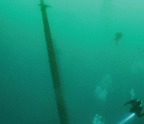Deathblow on Lake Superior!



Captain Alexander McDougall (1845-1923), between 1888 and 1898, a time when steel gradually replaced wood as the material of choice for shipbuilding on the Great Lakes, constructed 40 steel vessels of a rather unique and revolutionary design. Proudly called “whalebacks” by their designer, these ships resembled rounded, smooth-decked, semi-submerged, giant cigars or submarines bearing bows that looked like pigs’ snouts, enticing the less respectful to refer to these vessels as “pigboats,” a nickname which, unfortunately, drew quick acceptance in common usage.
McDougall’s most productive year was 1892, when his American Steel Barge Company of Superior, Wisconsin, the “twin city” across the bay from Duluth, Minnesota, at the extreme western end of Lake Superior, launched ten whalebacks, including four that shared the exact same hull dimensions: 308 feet (93.3 metres) in length, 38 feet (11.5 metres) in beam, and 24 feet (7.3 metres) in draft. These four sister ships, three steamers and a barge, were the Thomas Wilson, launched on April 30, 1892; the Samuel Mather, launched on May 2, 1892, renamed the Clifton in 1923, and lost in a Lake Huron storm in 1924 (see WDM #42, From the Debris Field…. about its recent discovery); the James B. Colgate, launched on September 21, 1892, and foundered in Lake Erie’s Black Friday Storm of 1916 (see WDM #40, From the Debris Field…. for its tale); and the engineless barge named the Sagamore, launched on July 23, 1892, and lost in Lake Superior after a collision with another ship in 1901 (see WDM #14 for that complete story.)
The Thomas Wilson, the largest whaleback in the world at the time of launching, became, tragically, the very first steamship of its type to sink with loss of life.
Captain Thomas Wilson, master of the steamer Meteor in 1867, had hired the younger Alexander McDougall as Mate, operating the ship between Cleveland and ports on Lake Superior. McDougall fell in love with the largest and wildest of the Great Lakes, and moved to the pioneer town of Duluth from Collingwood, Ontario, in the early 1870s.

In 1880, Captain Wilson persuaded McDougall to oversee the construction of two of the largest wooden ships built to date on the Great Lakes: the 235-foot [71.2-metre] steamer, , and its 200-foot [60-metre] tow barge, the With this huge project, McDougall gained considerable experience in ship which towed the he thought out his plan to design a steel ship that could “carry the greatest cargo on the least water” – the whaleback.
You’re reading a preview, subscribe to read more.
Start your free 30 days



